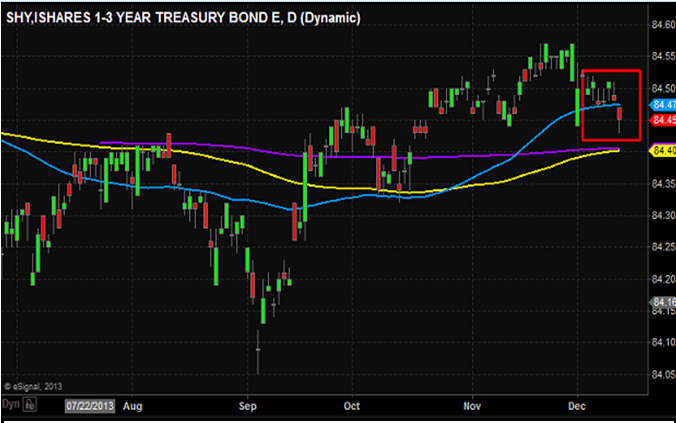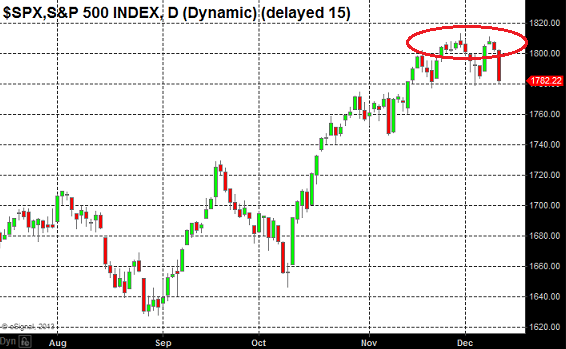Archive for month: December, 2013
What Could Go Wrong in ‘14—A Thought Experiment
/in Investing/by Tom 2As I start to think about the outlook for 2014, my mind almost always wanders first to “what could go wrong in the financial markets this year?” Having been raised in this business as a trader, I learned early that avoiding disaster is the first step to making money. So, I’ve spent some time thinking about what could go “wrong” in 2014.
Maybe I’m just a product of my environment, but I entered this business in the dot-com bubble burst of the summer of 2000, started on the floor one year after 9/11, and after a few good years then ran smack into the financial crisis. So, despite my relative youth, I’ve seen a lot of mess over a relatively short time.
Now, in fairness, the macro-horizon is as “clear” as it has been for some time. Europe is no longer teetering on the brink of a breakup or massive sovereign default. The financial system and banks are well-capitalized and as healthy as at any time since the crisis. Even the U.S. government appears to be trying to behave, as we’ve got a budget for the next two years (and the debt ceiling won’t be a drama in an election year—I don’t care what the Republicans say now). So, all things considered, the horizon looks pretty clear.
But, as I look for places where something could go “wrong,” I keep coming back to the bond market. I don’t think there are many people who would argue that the bond market, in general, reached “bubble” territory (or at least a blow-off top of a 30+ year bull market) over the past few years.
There are multiple measures to imply this is the case, whether it’s the amount of assets that have poured into the bond market, the amount of corporate issuance, or risk spreads compressing to historic lows, etc.
But, importantly, a declining bond market, by itself, doesn’t mean a crisis. Bonds can go down like any other asset and not cause a crisis that infects other asset classes. But, what makes me nervous about a crisis emanating from the bond market is the fact that we have a market in a blow-off top that was largely manufactured by government policy (the Fed), combined with government-mandated structural changes to the industry that has drained liquidity and will likely have multiple unintended consequences. (I’m referring to Dodd-Frank.)
And, this sort of dangerous cocktail should sound familiar to people. The potential negative consequence of this, of course, is a stampede to the exit by investors, but no one to buy the dip—causing a liquidity crisis in the bond market, and specifically the corporate bond market (with ground zero potentially being the high-yield market). And, the potential set-up is for a liquidity crisis in the corporate bond market that infects all other asset classes (like subprime did to everything else).
Throw in the explosion of bond-related ETFs and the retail money that’s flooded into them, and I can imagine a scenario where there is lots of selling of these ETFs and mutual funds. This in turn results in the bonds themselves having to be sold, but there simply being “no bid” for the specific corporate bonds, which then breeds a liquidity crisis that begins to feed on itself.
This report isn’t the venue for an in-depth analysis of the risks, but a client sent me an excellent report by McKinsey on this subject (I’m lucky to have a lot of smart people as subscribers), and the link is here. We got a warning shot on this in May/June of last year, and this is a concern that is starting to make the rounds among smart people.
I’m not a Pollyanna, but as I think of risks coming out of left field that could result in an end to this rally, this is the one that keeps popping up in my head. Again, this is a very, very low probability scenario, and one that likely won’t ever come to fruition. But if we’re looking for something that could go wrong next year, the pieces are in place.
FOMC Meeting Preview
/in Investing/by Tom 2- No tapering of QE in December, but a strong signal by the Committee that tapering of QE will happen in January or March.
- Tapering Logistics: If asked about how tapering will work, the market expects to see an initial tapering of $10 billion-$15 billion, and the process to be linear (tapering the same amount each month or quarter, whichever they decide). And, markets expect the first taper to be weighted toward Treasuries, while mortgage-backed securities are left alone (to help soften the blow on the mortgage market, although I’m not sure it’ll make much of a difference).
If this is what we get Thursday, don’t expect any significant, volatile reactions from the various asset classes, as again this is what’s priced in. As far as how markets will trade beyond the immediate reaction, that’s a tough one to call. We could either see a “sell the taper rumor/buy the taper news” reaction. Or we could see markets drop on the news, due as much to the calendar and the skittishness of money managers I’ve been talking about, given the gains so far this year. Read MoreThe Economy: A Look Back and What’s Ahead (12.16.13)
/in Investing/by Tom 2Last Week
There was very little economic data released last week, and economically the focus was on trying to “game” the chances of the Federal Open Market Committee announcing a plan to taper QE after their meeting this week.
The two major pieces of data (retail sales and jobless claims) we received last week generated mixed signals. Positively, retail sales beat expectations, and the important “control” group—which excludes automobile, gasoline and building-material purchases—continued to advance, rising 0.53% in November.
This uptick in retail sales came at a good time, as concerns about the consumer linger, especially given many retailers’ unenthusiastic commentary on the holiday shopping season. In fact, the resilient consumer (and stronger retail sales) resulted in many analysts and strategists upping their Q4 GDP estimates, as Personal Consumption Expenditures (i.e., consumer spending) are now expected to be stronger than originally thought.
The retail sales beat was the economic “highlight” of the week, and from a WWFD (What Will the Fed Do) standpoint, it very slightly upped the chances of a taper this week. However, it certainly won’t be the deciding factor.
On the flipside, jobless claims saw a jump of 68K, to 368K, as statistical errors thanks to Thanksgiving and other factors were worked out. That number was obviously a disappointment vs. expectations, but weekly claims have been so volatile lately that many people are discounting the adjustment. And, most (including me) expect claims to move south toward the lower-300K range, where it’s been since August.
However, the most-important economic news of last week (both for the economy and with regard to WWFD) came from Washington, where a two-year budget deal was struck and passed by the House.
From a market standpoint, the budget agreement provides some much-needed clarity for the market, and helps remove another potential macroeconomic risk from the horizon (there won’t be another budget battle or threat of shutdown).
Finally, the agreement is being viewed (correctly) as incrementally increasing the chances of a December taper—although like retail sales, it won’t be the deciding factor.
Bottom line, last week’s retail sales data was positive and confirms the overall feeling that the economy is improving. From a WWFD standpoint, the odds of a “Santa taper” this week did increase, although it remains somewhat of a long shot.
This Week
The FOMC announcement Wednesday is the most-important event this week and, for the next few days, Wall Street will be focused squarely on its outcome. I’ll preview what to expect in Wednesday’s Report, but as of right now the “consensus” expectation is for no tapering at this meeting, although it is certainly possible. Keep in mind this meeting also brings the FOMC’s forecasts for growth, inflation and interest rate policy expectations (so it’ll be an opportunity for the FOMC to further emphasize its zero-interest-rate policy). We also have the Chairman’s press conference, which will be the last with Ben Bernanke at the podium.
Away from the FOMC, there is also a lot of data coming out this week about the real economy. While the FOMC will dominate the conversation all week, keep this in mind: The only reason the market isn’t throwing a “taper tantrum” is because the economy looks to be improving. If that changes and the data turns south, the market won’t be as receptive to tapering as it currently is. Point being—the Fed is watching the data and everyone else, in turn, is watching the Fed for clues about where the numbers are heading next.
Later this morning we’ll get the “flash” manufacturing PMI for December, which will be closely watched. We also get Empire State Manufacturing (today) and the Philly Fed Manufacturing Index Thursday (they are usually the first economic data from the current month), although those two indices will have their thunder stolen this week given the “flash” PMI comes out before them.
This week also brings a bevy of housing data (Housing Market Index tomorrow, Housing Starts Wednesday and Existing Home Sales Thursday). The housing recovery remains the key lynchpin in the broader economic recovery. We saw over the summer that the housing market is sensitive to rising interest rates, so how the housing market is reacting to this recent uptick in rates will be important to see, both from a “real” economy and FOMC perspective. As I’ve been saying, the housing recovery can lose some momentum, but it needs to keep going so the economy can continue to accelerate.
Finally, jobless claims will reveal whether that big jump from last week starts to get reversed, and on Friday we get our last look at Q3 GDP. (Don’t expect any big revisions; they usually happen between the first and second revisions.)
Bottom line is it’s a big week from a policy and real economy perspective.
Address
4880 Donald Ross Rd., Suite 210
Palm Beach Gardens, FL 33418
info@sevensreport.com
Phone
(561) 408-0918


